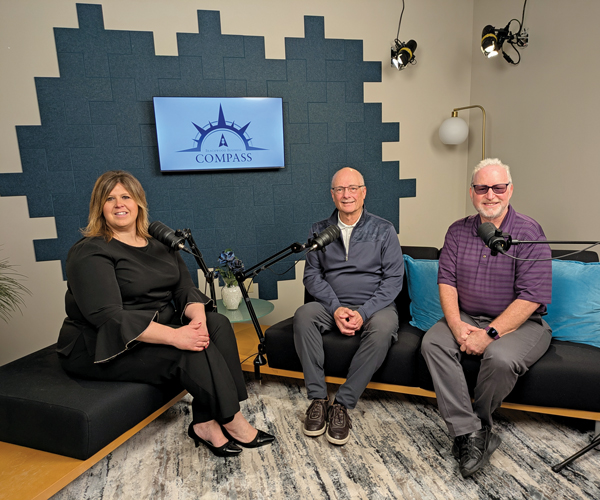Sometimes, you want to bank where everybody knows your name.
In the mutual banking model, the institution is owned by depositors instead of shareholders. It is actually finding renewed popularity throughout Northeast Ohio, as lending and branch staff work one-on-one with small business owners and sole proprietors, many of whom they know and regard as neighbors.
Kurt Kappa, chief lending officer of First Federal Lakewood, a mutual bank, doesn’t mind the comparison of a mutual bank to the personable Bailey Savings & Loan depicted in Frank Capra’s “It’s a Wonderful Life.”
“In the mutual banking model, people who are your neighbors deposit money into our bank, and we in turn invest it back into the community,” says Kappa. “Because we are depositor-owned, our clients are actually investing back into their community.”
Before the recent pandemic, many mutual banks were being rolled up into larger financial institutions that were more focused on making a profit and returning quarterly dividends to shareholders than they were on the needs of the local business community. When the pandemic hit and many small businesses faced economic upheaval, they found that mutual banks were in a unique position to help.
As with other mutual banks, First Federal Lakewood was able to focus its resources to serve the business needs of the community directly, coordinating community groups, local municipalities and economic development offices to support local businesses that were maybe getting shut out of larger financial institutions.
“We went through this once before during the economic downturn of 2008/2009,” says Kappa. “Now, with the pandemic, people are starting to reevaluate their banking relationships once again. They are realizing that bigger isn’t always better. They need a community bank who is going to stand by them, to be there for them during good times and bad.”
While it may sound like First Federal Lakewood is a small neighborhood bank, it’s actually the largest independent depositor-owned bank headquartered in Ohio. It offers that small-town business familiarity that’s backed with the assets of a major financial institution.
It has branches spread across Ohio as far east as Concord Township, as far west as Avon Lake and as far south as Columbus. It’s used its assets to help local businesses secure loans through the CARES Act Paycheck Protection Program (PPP), including over $105.5 million spread out over 1,259 loans as of June.
The average amount of each loan was $83,722, with less than 7 percent over $250,000. Those loans helped local businesses across Northeast Ohio retain 12,377 jobs.
First Federal Lakewood also is proud to have helped women and minority business owners, with over $42.5 million in total PPP loans, making up 40 percent of the company’s loan dollars. Eighty nonprofit organizations secured loans that totaled over $12.6 million.
“A lot of the lessons we use in the current pandemic we actually learned during the 2008 financial crisis,” says Kappa. “Specifically, that no individual or small business owner is going to come out or reemerge from the crisis in the same way. It’s not a one-size-fits-all solution.”
Being available, listening to customers and trying to understand their unique circumstances are key, he says.
While focusing on local communities is a part of its business model, helping out small businesses also has helped grow First Federal Lakewood’s business, says Kappa.
“By actively listening to our customers, putting ourselves in the business owners’ shoes and working with local communities, we have increased our business footprint dramatically,” he says. “Out of the new PPP loans we brought in to date, only about 400 were current customers, so we now have the opportunity to work with nearly 1,000 new businesses throughout Ohio.”
More importantly, Kappa is impressed with the spirit of the communities served by First Federal Lakewood.
“As a mutual bank, our focus is always about having customers and communities as the priority in all of our decisions,” he says. “We’re proud to say we were able to facilitate almost every single one of our new relationships with people who came through our door looking for assistance.”
It was a team effort, he stresses, and the results couldn’t have been achieved without civic cooperation.
“Everybody, and I do mean everybody across the board, was involved,” Kappa says. “From the communities to the economic development directors to local nonprofits — everybody stepped up to the plate, working with each other, not against each other, creating programs to make sure we were taking care of all of the businesses in our communities and neighborhoods. They were not sitting on their hands. They were active in the whole process.”
As one might expect, First Federal Lakewood worked very closely with its home city.
“Lakewood certainly comes to mind,” he says. “I thought it was amazing how the city of Lakewood worked with LakewoodAlive. I’m just happy that our business model allowed us the flexibility to work, not only with Lakewood, but all of the communities we serve.”
Certainly, First Federal Lakewood has shown that it will “put its money where its mouth is,” when it comes to serving businesses and communities. That has it uniquely positioned for the future.
“We have always been known as a community partner, but more importantly, our recent efforts have really put us on the map,” says Kappa. “Small and midsize businesses saw what we were able to do, saw that we were a true partner. The next step is seeing what we can do for future growth, not only for our team here at First Federal Lakewood, but also for our community and our business relationships across Northeast Ohio.”




